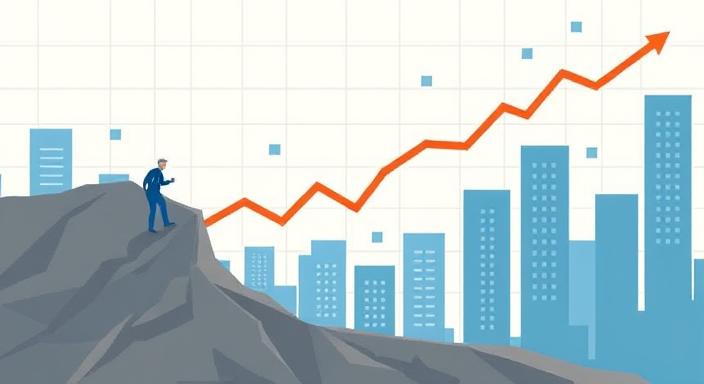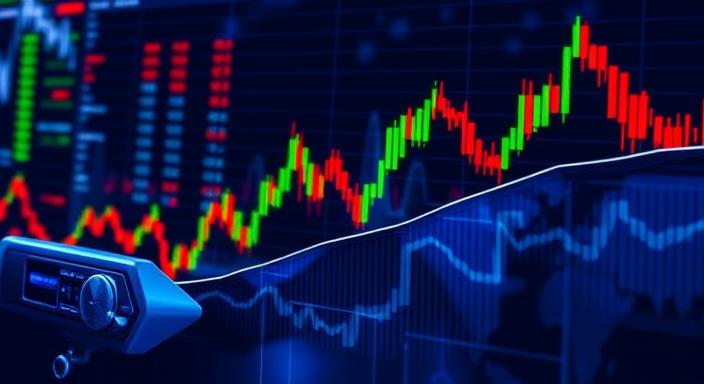An Introduction to Advanced Stock Market Research Navigating
This briefing looks at recent stock market ups and downs. It explores the main causes and shares what investment strategists think. We base our analysis on “The Stock Market Is A Bubble That’s About to Burst.” This piece is for investors worried about the sharp drop in the stock market today.
I. Executive Summary
The stock market has experienced a sudden decline. Major indices like the S&P 500, Dow, and NASDAQ have dropped significantly. Public mood has turned anxious, particularly for new investors. A historic crash like 2008 seems likely in our minds. A closer look reveals that, despite worries, these factors may not cause disaster.
The main reasons for the downturn are:
- Fear of a recession
- Recent interest rate changes by the Federal Reserve
- The stock market, seen as a bubble, especially in tech stocks linked to AI
- Changes in Japan’s yen interest rates
Nevertheless, the source does not offer an easy way out:

It supports a long-term, diverse investment strategy. It focuses on stable assets. Some downturns are normal in stock market growth.
II. Key Themes and Key Concepts/Facts
A. Current Market Decline and Investor Concern:
The market took a big hit. The S&P 500 fell by 3%, the Dow dropped 2.6%, and the NASDAQ declined 3.4%. This was the biggest one-day drop in nearly two years.
This has aroused a public “panic,” with “terror” and “worry” appearing among stakeholders. Many social media comments say, “The stock market is hopeless,” and “I’m selling everything.” This source wants to explain the “mayhem” and help people “join the tide of indecision.”
B. Four Main Causes of the Stock Market Plunge:
The fear of recession:
“If new sales in car manufacturing drop, it becomes tough to break even.”
Consumer demand dropped due to company layoffs. Corporate profits also declined during recessions. In 1993, estimates showed the economy needed more growth to prevent another depression.
“But investors won’t know if they live that long.”
The authorities activated the Sarm Rule after July’s US job numbers fell short. They reported just 114,000 jobs added. Also, unemployment climbed to 4.3%.
It starts when the unemployment rate rises by 0.5% or more over three months. This happens during its “lowest months” of the year.
Since World War II, it has accurately predicted every US recession. Navigating
Claudia Sarm and Arthur Okun first heard her news at the Brookings Institution in 1979. They believe this move isn’t right at the moment.
Goldman Sachs now puts the odds of recession at 25%. They still think it’s “quite unlikely.” This is partly because consumers are saving about 26 cents on the dollar instead of 29.
Consumer spending also shows signs of slowing. “Some consumers are spending less,” said representatives from McDonald’s, Walmart, and Wayfair..
Interest Rates and Federal Reserve Actions:
The Federal Reserve often shifts its policy when it sees economic weakness. Last month, it suggested lowering interest rates. This followed a meeting that celebrated its successes. As a result, stock indices corrected.
Consequently, this time is different. In 2022, interest rates rose sharply. This “unprecedented situation” was meant to tackle high inflation. It arose from the crash and supply chain issues. It also involved Qataris selling US dollars to improve their balance sheets.
The Federal Reserve is cutting rates. They’ve set a target for inflation and are close to reaching it.” In other words, it’s not to stop a recession.
Lowering interest rates “could be a good move for investors because it helps the economy grow.”
Tech Stocks and the AI Bubble:
Experts say that “tech stocks” have dropped more than others. This includes the “Magnificent Seven”: Apple, Amazon, Alphabet, Meta, Microsoft, Tesla, and Nvidia.
These seven stocks make up 31% of the S&P 500. So, their changes can greatly impact the entire index. (See chart.)
The “AI craze is leading to a bubble, and some stocks are just going out of sight.”
But this is being recognised now, reducing the prices of all kinds of stocks.
Manifestly, some evidence can be inferred. Berkshire Hathaway, run by Warren Buffett and Charlie Munger, has cut its stake in Apple Inc. Apple Intelligence’s results were disappointing. They fell short of expectations, dropping by almost fifty percent. Also, there are delays in NVIDIA Corp.’s Blackwell chip.
What we are seeing now is “a little like what happened in the late 1990s when I first started to invest.”
Japanese Yen:
Traders made money by borrowing cheap Japanese yen. They used this to buy other currencies when the yen was strong. Later, they sold those currencies after the yen’s value dropped.
The Bank of Japan was forced to raise its key interest rate from quasi-zero.
The Bank of Japan then “relaxed” and stopped raising rates. This let the yen “ease off” a bit, which has provided “some kind of reassurance.”

“Buy When Blood is in the Streets” / “Buy on Dips” In a bear market, it is an opportune time to buy. “The public is selling, driving prices down to unreasonable levels.” Emergency Fund: “It’s important to save 3 to 5 months’ worth of living expenses. This way, you won’t have to sell stocks at a loss.” Dollar-Cost Averaging: “Buy in at regular intervals as the price drops, by a low-cost S&P 500 Index Fund.”
Recommended for those “waiting for the perfect chance to jump in.”
Diversification means spreading your money across various assets. This includes stocks, bonds, and crypto. It helps lower your risk.
The S&P 500 is diverse, but it’s “top-heavy with tech companies.” So, consider buying a “total U.S. stock market fund.”
Keep Your Eye on the Long Game:
“Do not be tempted to sell everything” just because the market is down. “In every single case where I’ve made that decision, staying has paid off.” Selling during a downturn “makes those losses permanent.” For example, a $1,000 investment during the COVID-19 crash could:
Destruction; Never recover at all and remain forlorn in his mind
At this time, we have no reports on:
Chinese market (Washington Post, NYT, 6)
The S&P 500 Index is still up by more than 9% since January.
Market corrections, or a Falcon 11 dive of 10% or more from recent highs, happen every year and a half to two years. This pattern has been true for a long time. So this isn’t necessarily cuckoo.”
A great quote captures this: “When the stock market rises, it takes the stairs. But when it falls, it jumps out the window.” Recently, we’ve jumped from a high floor after climbing many stairs.
“Now, they have put SO IV.” Other factors to consider:
Many factors can worsen the situation, not the stock market decline, often called a “crisis.” Investors may view recent stock drops as new events or shifts from past trends.
The source highlights that people can understand these changes. They can stick to key investment principles like diversification, liquidity, and dispersion. One way to do this is by building an emergency capital stockpile. The author says this method helps you face challenges and seize new opportunities.
The net effect shows strength. Focus on the “long game.” Don’t panic over short-term changes or chase quick profits.


